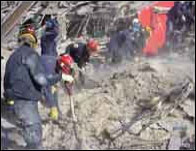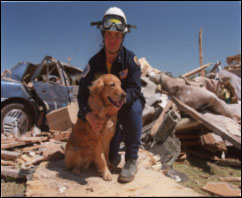Earthquakes Guide
NOTE:
The Occupational Safety and Health Act (OSH Act) requires employers to comply with hazard-specific safety and health standards. In addition, pursuant to Section 5(a)(1) of the OSH Act, employers must provide their employees with a workplace free from recognized hazards likely to cause death or serious physical harm. Emergency Preparedness Guides do not and cannot enlarge or diminish an employer's obligations under the OSH Act.
Emergency Preparedness Guides are based on presently available information, as well as current occupational safety and health provisions and standards. The procedures and practices discussed in Emergency Preparedness Guides may need to be modified when additional, relevant information becomes available or when OSH Act standards are promulgated or modified.
General Information
What is an earthquake?
An earthquake is a sudden, rapid shaking of the ground caused by the breaking and shifting of rock beneath the Earth's surface. This shaking can cause buildings and bridges to collapse; disrupt gas, electric, and phone service; and sometimes trigger landslides, avalanches, flash floods, fires, and huge, destructive ocean waves (tsunamis). Buildings with foundations resting on unconsolidated landfill, old waterways, or other unstable soil are most at risk. Buildings or trailers and manufactured homes not tied to a reinforced foundation anchored to the ground are also at risk since they can be shaken off their mountings during an earthquake. Earthquakes can occur at any time of the year.
What hazards are associated with earthquakes?
When an earthquake occurs in a populated area, it may cause deaths and injuries and extensive property damage. Ground movement during an earthquake is seldom the direct cause of death or injury. Most earthquake-related injuries result from collapsing walls, flying glass, and falling objects as a result of the ground shaking, or people trying to move more than a few feet during the shaking. Much of the damage in earthquakes is predictable and preventable.
What are aftershocks?
Aftershocks are smaller earthquakes that follow the main shock and can cause further damage to weakened buildings. After-shocks can occur in the first hours, days, weeks, or even months after the quake. Be aware that some earthquakes are actually foreshocks, and a larger earthquake might occur.
What can I do to prepare before an earthquake occurs?
- Pick "safe places". A safe place could be under a sturdy table or desk or against an interior wall away from windows and bookcases, or tall furniture that could fall on you. The shorter the distance to move to safety, the less likely you will be injured. Injury statistics show that people moving as little as 10 feet during an earthquake's shaking are most likely to be injured.
- Practice drop, cover, and hold-on in each safe place. Drop under a sturdy desk or table and hold on to one leg of the table or desk. Protect your eyes by keeping your head down. Practice these actions so that they become an automatic response.
- Practice drop, cover, and hold-on at least twice a year. Frequent practice will help reinforce safe behavior. When an earthquake or other disaster occurs, many people hesitate, trying to remember what they are supposed to do. Responding quickly and automatically may help protect you from injury.
- Wait in your safe place until the shaking stops, then check to see if you are hurt. You will be better able to help others if you take care of yourself first, then check the people around you. Move carefully and watch out for things that have fallen or broken, creating hazards. Be ready for aftershocks.
- Be on the lookout for fires. Fire is the most common earthquake-related hazard, due to broken gas lines, damaged electrical lines or appliances, and previously contained fires or sparks being released.
- If you must leave a building after the shaking stops, use the stairs, not the elevator. Earthquakes can cause fire alarms and fire sprinklers to go off. You will not be certain whether there is a real threat of fire. As a precaution, use the stairs.
- If you're outside in an earthquake, stay outside. Move away from buildings, trees, streetlights, and power lines. Crouch down and cover your head. Many injuries occur within 10 feet of the entrance to buildings. Bricks, roofing, and other materials can fall from buildings, injuring persons nearby. Trees, streetlights, and power lines may also fall, causing damage or injury.
- Inform workers of the plan. Everyone in your workplace should know what to do if an earthquake occurs.
- Get training. Take a first aid class from your local Red Cross chapter. Get training on how to use a fire extinguisher. Keep your training current. Training will help you to keep calm and know what to do when an earthquake occurs.
- Discuss earthquakes with workers. Everyone should know what to do. Discussing earthquakes ahead of time helps reduce fear and anxiety and lets everyone know how to respond.
- Participate in the Great Shake Out Earthquake Drills conducted the third Thursday of every year in October.
Emergency Responders
Collapsed structures are a common result of earthquakes. Rescue workers and emergency responders may have to enter collapsed structures to perform search and rescue activities, and it is vital that they perform their duties safely.
What is a collapsed structure?
When internal load bearing structural elements fail, a building will collapse into itself and exterior walls are pulled into the falling structure. This scenario may be caused by construction activity, an earthquake or fire and may result in a dense debris field with a small footprint. Alternatively, if the structural failure is caused by an explosion or natural forces such as weather, the building may collapse in an outward direction resulting in a less dense and scattered debris field.

Who enters a collapsed structure?
Following a catastrophic failure of a structure, rescue workers and emergency responders may be required to enter the collapsed structure. Emergency responders include firefighters, police, emergency medical technicians, construction workers and government representatives. Emergency responders may be responsible for assisting survivors, extinguishing fires, shutting off utilities, assessing structural instabilities, shoring-up safe paths into the structure and assessment of other hazards such as airborne contaminants. Rescue workers such as Urban Search and Rescue Teams focus on finding survivors and later removing victims from collapsed structures.
Organizing Rescue Workers and Emergency Responders
What is the organizational structure for the response to these events?
Although these catastrophic events may initially be quite chaotic, eventually site management will be under a unified command such as the recognized Incident Command Structure. Local responders and rescuers will obviously respond first with the State requesting Federal Emergency Management Agency (FEMA) assistance if warranted.
A trained Structures Specialist from Urban Search and Rescue will be responsible for:
- Evaluating the immediate structural condition of the area to be entered during rescue operations.
- Determining the appropriate type and amount of structural hazard mitigation in order to minimize risks on site to rescue personnel.
What safety and health resources are available during a collapsed structure response?
Once the Incident Command System is established at a collapsed structure, the Incident Commander maintains accountability for all response personnel at the scene. A Safety Officer may also be mobilized and report directly to the Incident Commander. The Safety Officer is responsible for monitoring and assessing the safety aspects of the responders during the collapsed structure event. The Safety Officer's responsibilities may include:

- Overseeing all safety and health aspects of response personnel
- Assuring that optimal safety and injury prevention is practiced
- Investigating and documenting all response team injuries and illnesses
- Preparing and maintaining entry permits
- Ensuring that appropriate personal protective equipment (PPE) is used
- Developing and implementing daily health and safety plans which address (1) sanitation, (2) hygiene, (3) PPE, (4) Decontamination, (5) work/rest cycles, (6) acute medical care, etc.
- Interviewing off-going shifts to assess developing hazards
- Assessing risk for the identified hazards; and
- Training in hazard awareness and use of PPE
- Assessing structural instabilities
What hazards may be encountered when entering a collapsed structure?
The following hazards should be considered in order to protect rescue workers and emergency responders when preparing to enter a collapsed structure:

- Water system breaks that may flood basement areas
- Exposure to pathogens from sanitary sewer system breaks
- Exposed and energized electrical wiring
- Exposure to airborne smoke and dust (asbestos, silica, etc.)
- Exposure to bloodborne pathogens
- Exposure to hazardous materials (ammonia, battery acid, leaking fuel, etc.)
- Natural gas leaks creating flammable and toxic environment
- Structural instability
- Insufficient oxygen
- Confined spaces
- Slip, trip or fall hazards from holes, protruding rebar, etc
- Being struck by a falling object
- Fire
- Proximity to heavy machinery such as cranes
- Sharp objects such as glass and debris
- Secondary collapse from aftershock, vibration and explosions
- Unfamiliar surroundings
- Adverse weather conditions
- Noise from equipment (generators/heavy machines)
Additional Federal Resources
- Disaster Information Management Research Center - Health Resources for Haiti, Post-Earthquake. U.S. National Library of Medicine, National Institutes of Health.
- Earthquakes. National Institute of Environmental Health Sciences, Worker Education and Training Program.
- Emergency Response Resources - Disaster Site Management. National Institute for Occupational Safety and Health (NIOSH) Workplace Safety and Health Topic.
- Earthquakes. Centers for Disease Control and Prevention (CDC).
- Emergency Response Resources - Emergency Responders. National Institute for Occupational Safety and Health (NIOSH) Workplace Safety and Health Topic.
- Preventing Injuries and Deaths of Fire Fighters due to Structural Collapse. National Institute for Occupational Safety and Health (NIOSH) DHHS NIOSH Publication No. 99-110, NIOSH Alert (August 1999).

